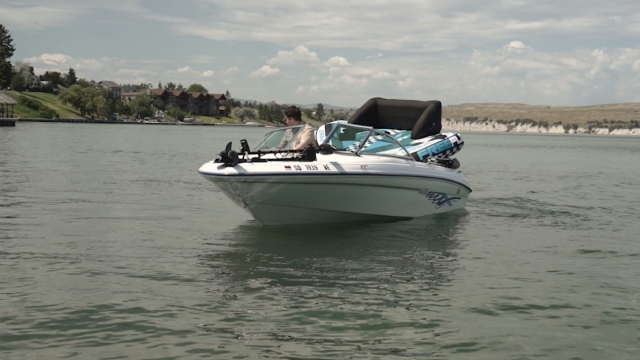About 100 miles north of Missoula, Montana, Flathead Lake has been a boater's paradise for decades. But that's changing for some boat owners this summer.
"I'm one of the few people that have my boat in," said Randy Holm, a Flathead Lake boat owner. "Most of my neighbors pulled theirs. They never pull their boats ever till the end of August or mid-September."
But that's the reality this year for many boat owners on northwest Montana's pristine Flathead Lake, the largest freshwater lake west of the Mississippi.
Brian Lipscomb, the CEO of the Native American-owned power company Energy Keepers, says "the water is the lifeblood of us as tribal people."
"You can't get more important than that," Lipscomb said. "And our relationship with the water is paramount. Without it, we're not here."
And now, that water is down almost two feet below what's considered full pool. That's never happened during the summer months since the lake's SKQ hydroelectric dam was built on the southwest end in the 1930s. It's owned by Energy Keepers, a corporation of the Confederated Salish and Kootenai Tribes, which generates electricity for customers in Montana and across the West.
SEE MORE: Blood-sucking sea lampreys on the rise in Great Lakes again
"It has never happened before. We have never been this low in the period of record for water supply coming in the lake, ever," said Lipscomb.
Some frustrated locals have asked if the water could have been managed better through the SKQ dam, and the amount of water released from the lake. Operators say it's not about water being let out but a lack of water coming in because of drought and changing climate conditions.
"Well, I can't create water. You know, we can only do what we can do with the water that's coming," said Lipscomb.
Steve Running, a climate change expert and Nobel Prize winner believes "water management is going to define the West for better or for worse because we are in an arid and semi-arid climate this whole side of the continent."
A license from the federal government requires the dam to release a minimum amount of water downstream for endangered species protection. SKQ operators say they went to near minimum outflows back in March. But it wasn't enough to keep levels up.
"Every single month, the water supply forecast has come in below average, except for May," said Lipscomb.
A dry winter followed by an extremely warm May meant a rapid melt of snowpack all at once.
"I started giving public climate talks about 25 years ago, and from the very beginning I emphasized water deficits and aridity and early snowmelt," said Running. "And these are literally the same topics that 25 years ago I was saying are on their way. And sure enough, they're here. Scientifically, they're not surprises."
SEE MORE: Hunting for sapphires and other gems on the banks of Montana river
Now, SKQ dam operators say it's a zero-sum game. The lowest amount of water that can be released from the lake is more than what's coming in naturally through rain and snowmelt.
"It's a big deal. And so from that perspective, you know, we have to think, well, this is the tip of the iceberg," said Lipscomb.
It's a problem we've seen elsewhere in the West. Lake Mead, which supplies most of the water used in the Las Vegas Valley, fell to record lows this time last year. At Flathead, the issue is more than just having a lake for Montanans to boat on.
"For us, it's generation. In the entire region, hydropower is about 60% of what we're normally generating this time of year for electricity."
Downstream, low flows are also hard on native fish. It's impacting farmers who rely on the water for irrigation. There are also economic impacts of a shrinking lake, with local officials estimating Flathead generates hundreds of million dollars in recreational spending.
"It's unfortunate. And I'm sure it's hurting some businesses around here," said Holm.
Ryder Trent, manager of Old Faithful Water Sports explains, "Three months out of the year is all of our business. And so when we start seeing it slow down, just because of the water level, that's a big bummer for, I mean, everybody."
Some businesses have used floatable docks that can adjust to different water levels but not all can afford them, leading to reduced revenue through things like rentals and fuel sales.
A push by local politicians to add more water from the Hungry Horse Reservoir upstream was denied, with the Columbia River Basin Technical Management Team (TMT) citing concerns over impacts on fish and water levels next year. As it stands, people who want to recreate on Flathead Lake may need to make some adjustments.
"It's still a beautiful lake. I don't think we lose that. I think we lose this, this luxury of having the lake at full pool through the entirety of the summer. You know, that's a luxury that's been afforded to us since the dam was built," said Lipscomb.
Trending stories at Scrippsnews.com




